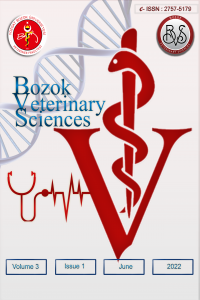Bir İnekte Dicephalus Bağlı Güç Doğum Olgusu
Monstroglia olarak geçen disefalus olgusu; iki başın tek gövdede bulunduğu kongenital bir bozukluktur. Bu olguda dört yaşında doğumun üçüncü aşamasında olan Simental ırkı bir inek son 2 gündür şiddetli kasılmaları olmasına rağmen doğumun gerçekleşmemesi şikayetiyle Atatürk Üniversitesi Veteriner Fakültesi Hayvan Hastanesine getirildi. Ölü dicephalus fetus sezaryen operasyonu ile başarılı bir şekilde uterustan çıkarıldı. İnek operasyon sonrası herhangi bir komplikasyon olmaksızın iyileşti.
Anahtar Kelimeler:
Dicephalus, Güç Doğum, İnek, Sezaryen Operasyonu
Dystocia due to Dicephalus in a Cow
Dicephalus, which is also referred to as Monstroglia, is a congenital disorder with two heads on one body. A non-descript cow in the third stage of labor and four years of age was brought to the animal hospital of Veterinary Faculty of Atatürk University with the history of straining for the for 2 days with unsuccessful attempts to deliver the fetus. Successful delivery of a dead dicephalic monster fetus by cesarean was recorded. Dam was recovered without any post-partum complication.
Keywords:
Caesarean Section, Cow, Dicephalus, Dystocia,
___
- 1. Verma M, Shah N, Yadav HP, Patel A, Saxena A. Caesarean section of non-descript cattle due to conjoined twins (dicephalus thoracopagus tetrabrachius tetrapus) monster calves: a case report. Journal of Experimental Zoology 2018; 21: 701-703.
- 2. Katiyar R, Khan F, Khan MM, Sachan S, Prasad S et al. Dystocia due to dicephalus monster with kyphosis and arthrogryposis in a cross bred cow-A case report. International Journal of Livestock Research 2015; 5: 64-66. doi: 10.5455/ijlr.20150603104639.
- 3. Mollalign M, Nibret M. A review on dystocia in cows. European Journal of Biological Sciences 2016; 8: 91-100. doi: 10.5829/idosi.ejbs.2016.91.100.
- 4. Sharma A. Caesarian section in animals under field conditions: A retrospective study of 50 cases. Indian Veterinary Journal 2006; 83:544-545.
- 5. Kuldeep SK, Singh R, Singh D. Dystocia due to dicephalus monster in a cow. Bulletin of Environment Pharmacology and Life Sciences 2018; 7: 41-42.
- 6. Singh G, Rishipal RD, Chandolia R. Monstrosities as a cause of dystocia-a study of 13 cases. Veterinary Practitioner 2020; 21: 103-106.
- 7. Singh G, Yadav R, Dangi P, Dutt R, Kumar S. Successful management of dystocia due to live dicephalic fetus in a non-descript cow: A case report. Veterinary Clinical Science 2020; 8: 3-4.
- 8. Sinowatz F. Teratology. Hyttel P, Sinowatz E, Vejlsted M. eds. In: Essentials of Domestic Animal Embryology. First Edition. Philadelphia: Saunders, 2010; pp. 338-382.
- 9. Noakes D, Parkinson T, England G. Dystocia and other disorders associated with parturition. Noakes DE, Parkinson TJ, England GCW. eds. In: Veterinary Reproduction and Obstetrics. Tenth Edition. US: Elsevier, 2019; pp.207-305.
- 10. El-Sheikh H, Hegab A, Zaabel S. Dicephalic atlodymus monster associated with hydrops amnii in a buffalo cow: A case report. Veterinary Research 2010; 3: 46-48. doi: 10.3923/vr.2010.46.48.
- 11. Finberg HJ. Callen’s Ultrasonography in Obstetrics and Gynecology. Sixth Edition. Philadelphia: Elsevier, 2017.
- 12. Srivastava S, Kumar A, Maurya S, Singh A, Singh V. A dicephalus monster in Murrah buffalo. Buffalo Bullettin 2008; 27: 231-232.
- 13. Kumar P, Sharma A, Singh M, Sood P, Barman P. Dystocia due to a dicephalus monster fetus in a buffalo. Buffalo Bullettin 2014; 33: 13-15.
- 14. Jackson P. Handbook of Veterinary Obstetrics. Second Edition. Edinburgh: Saunders, 2004; pp. 141-66.
- Yayın Aralığı: Yılda 2 Sayı
- Başlangıç: 2020
- Yayıncı: Yozgat Bozok Üniversitesi
